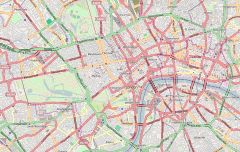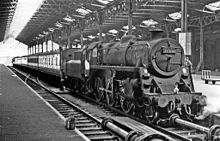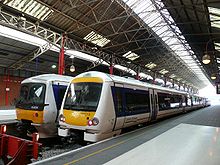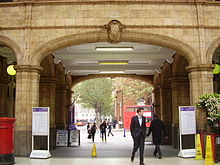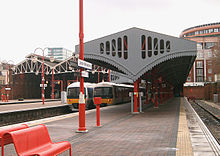- Marylebone station
-
Marylebone 

London Marylebone
Main Entrance
Location of Marylebone in Central LondonLocation Marylebone Local authority City of Westminster Managed by Chiltern Railways Owner Network Rail Station code MYB Number of platforms 6 Accessible  [1]
[1]Fare zone 1 Interchange Baker Street [2]
Edgware Road (Circle)
Paddington (National Rail)London Underground annual entry and exit 2008  11.380 million[3]
11.380 million[3]2009  11.730 million[3]
11.730 million[3]2010  11.390 million[3]
11.390 million[3]National Rail annual entry and exit 2004-05  6.949 million[4]
6.949 million[4]2005-06  6.819 million[4]
6.819 million[4]2006-07  11.639 million[4]
11.639 million[4]2007-08  11.559 million[4]
11.559 million[4]2008-09  11.645 million[4]
11.645 million[4]2009-10  11.758 million[4]
11.758 million[4]1899 Opened 1966 GCML beyond Aylesbury closed 1996 Birmingham services begin 2006 Two new platforms built 2008 Services to Wrexham begin 2011 Services to Wrexham end List of stations Underground · National Rail External links Departures • Layout Facilities • Buses Coordinates: 51°31′20″N 0°09′48″W / 51.5223°N 0.1634°W
Marylebone station, also known as London Marylebone[5] (pronounced /ˈmɑrlɨbən/ (
 listen) mar-li-bən), is a central London railway terminus and London Underground complex. It stands midway between the mainline stations at Euston and Paddington, about 1 mile (1.6 km) from each. Originally the London terminus of the ill-fated Great Central Main Line, it now serves as the terminus of the Chiltern Main Line route.
listen) mar-li-bən), is a central London railway terminus and London Underground complex. It stands midway between the mainline stations at Euston and Paddington, about 1 mile (1.6 km) from each. Originally the London terminus of the ill-fated Great Central Main Line, it now serves as the terminus of the Chiltern Main Line route.Opened in 1899, it is the youngest of London's mainline terminal stations, and also one of the smallest, having opened with half the number of platforms originally planned. It is also the only terminal station in London to host only diesel trains, having no electrified lines. From 1967 for many years it was served only by diesel multiple-unit trains (DMUs). Occasionally special trains hauled by diesel or steam locomotives also visit Marylebone.
Two new platforms have been added recently to cope with an increase in services and a growing number of passengers. Marylebone is in Travelcard Zone 1.
Contents
Location
The station stands just off Marylebone Road, a major thoroughfare in the Marylebone area of central London. Nearby attractions include Regents Park, Lord's Cricket Ground, Baker Street and Madame Tussauds.
National Rail
The mainline station has six platforms; two originally built in 1899, two inserted into the former carriage road, and two built in September 2006. The latter addition made Marylebone no longer the smallest railway terminal in London, although apart from the now defunct Waterloo International (replaced by the terminus at St Pancras Station, which opened in November 2007) it remains the newest. It is the only non-electrified terminal in London. Marylebone is operated by Chiltern Railways, making it the only London terminal station not to be managed by Network Rail (a distinction previously shared with London Blackfriars, managed by First Capital Connect, the work at Blackfriars in connection with the Thameslink Programme having removed the terminal platforms).
Train services into the station are run by Chiltern Railways which serves the Chiltern Main Line and London to Aylesbury Line routes to High Wycombe, Aylesbury, Bicester, Banbury, Leamington Spa, Stratford-upon-Avon, Birmingham (Snow Hill), and Kidderminster.
Around 11.6 million passengers passed through Marylebone between 2006/2007, an increase of 4.8 million since 2005/2006, a 70% rise in just a year. This makes it London's fastest-growing passenger rail terminal by percentage growth rate.
History
Pre 1958 - GCR and LNER
The station was opened on 15 March 1899[6][7] and was the terminus of the Great Central Railway's new London extension main line — the last major railway line to be built into London until High Speed 1. The designer was Henry William Braddock,[8] a civil engineer for the Great Central Railway.[9] The design is in a modest, uninflated domestic version of the "Wrenaissance" revival style that owed some of its popularity to work by Norman Shaw; it harmonises with the residential surroundings with Dutch gables, employing warm brick and cream-coloured stone.
Originally Marylebone is said to have been planned as a ten-platform station,[citation needed] but the cost of building the GCR was far higher than expected and nearly bankrupted the company,[10] causing the station to be scaled back to just four platforms, three within the train shed and one west of the train shed (platform 4).[11] The concourse is unusually long and, for some 50 years, had only three walls, the northern wall being missing, as the GCR anticipated that the other six platforms, under an extended train shed, would be built later on. The cost of the London Extension also meant that the Great Central Hotel was built outside the station complex and by a different company.
The Great Central Railway linked London to High Wycombe, Aylesbury, Rugby, Leicester, Nottingham, Sheffield and Manchester. Local services from northwest Middlesex, High Wycombe and Aylesbury also terminated at Marylebone.
Passenger traffic on the GCR was never heavy, perhaps because it was the last main line to be built, which meant it had difficulty competing against longer-established rivals (especially the Midland Railway and its terminal St Pancras) for the lucrative intercity passenger business. Furthermore, for 40 miles between Aylesbury and Rugby the line traversed thinly-populated countryside, thus attracting little passenger business at intermediate stations. The GCR also struggled to compete with the Metropolitan Railway for 2nd- and 3rd-class traffic from nearby towns such as Harrow, Chesham and Aylesbury. However, the GCR had the upper hand on 1st-class travel between these towns, being quick, reliable and luxurious compared to the Met. Due to low passenger traffic, Marylebone was considered the quietest and most pleasant of London's termini, qualities underlined[clarification needed] by the present rail operator (Chiltern Railways).
While passenger traffic was sparse, the line was heavily used for freight, especially coal, and goods trains ran from the north and East Midlands to the former Marylebone freight depot which used to adjoin the station. The heyday of the line was between 1923, when the GCR was absorbed into the LNER[12] and 1948, when the LNER was nationalised to form the BR Eastern Region.[12] As a result many prestigious locomotives, such as Flying Scotsman, Sir Nigel Gresley, and Mallard which ran on the East Coast Main Line, were also frequent visitors to the line. Special trains also ran on the line to destinations such as Scotland.
1958 to 1980s - the cuts
Long-distance trains from Marylebone began to be scaled back from 1958 after their transfer from BR's Eastern Region to the London Midland Region (although Marylebone itself, and the first few miles of its route, had belonged to the Western Region since 1950),[13] as the former Great Central Main Line was regarded as a duplicate of the Midland Main Line. Meanwhile the Master Cutler, the line's daily crack London-Sheffield express, was diverted to London King's Cross and thenceforth ran via the East Coast Main Line. By 1960 there were no daytime trains running to destinations north of Nottingham, although a few still ran at night, and many express services were cut.[12] By 1963, local stopping services beyond Aylesbury and most intermediate stations had closed, and in 1965 freight services were curtailed.[12] Between 1960 and 1966 only a few long-distance "semi-fast" services remained, mainly steam-hauled by LMR 'Black 5s' - the days of the Great Central as a true main line were over. In 1966 the former Great Central Main Line was closed between Aylesbury and Rugby as part of the Beeching axe. This meant that Marylebone was now the terminus for local services to Aylesbury and High Wycombe only. The GCR's closure was the largest single railway closure of the Beeching era.
After the 1960s, lack of investment meant that the local services and the station itself became increasingly run down. Marylebone became the best place in London to see heritage trains. In the early 1980s there was a proposal to close Marylebone, divert British Rail services via High Wycombe into nearby Paddington, and extend the Metropolitan Line to Aylesbury, so London trains via Amersham would be routed to Baker Street. Marylebone was to be converted into a coach station with the tracks converted to a road for coaches only. However these plans were deemed impractical and quietly dropped.
1980s onwards - success
A major turnaround in the station's fortunes occurred in the late 1980s, when British Rail decided to divert many services from overcrowded Paddington station into Marylebone. The station was given a multi-million-pound facelift, financed by selling off the redundant adjacent goods yard and some land previously used by the platform beside the train shed (platform 2 in 1899, platform 4 after the present 2 and 3 were built on the site of the carriage road). The ageing fleet of trains (Class 115) on the local services was replaced by a fleet of state-of-the-art Class 165 Turbo trains.[citation needed]
Upon rail privatisation in 1996,[14] the station was given an even bigger boost when Chiltern Railways took over the rail services. Chiltern trains made the station the terminus for a new interurban service to Birmingham Snow Hill. To cope with Chiltern Railways' success over the last ten years and with increased passenger numbers, a new platform (platform 6) was inaugurated in May 2006. This was part of Chiltern's £70-million project Evergreen 2. Platform 5 and the shortened platform 4 opened in September 2006. The canopies on platforms 5 & 6 were built in a similar style to the canopy on the original platform 4, which was demolished in the 1980s. Additionally, a new depot has recently opened near Wembley Stadium railway station to compensate for the closure of Marylebone's station sidings and to make way for the new platforms. Some services from Marylebone have also now been extended beyond Birmingham to Kidderminster. Marylebone now serves more passengers than use the purely domestic services at St Pancras.[citation needed]
In late January 2006, a new company was formed called Wrexham & Shropshire. In September 2007, the Office of Rail Regulation granted the company permission to operate services from Wrexham (in North Wales) via Shrewsbury, Telford and the West Midlands to Marylebone, which started in early 2008. This restored direct London services to Wrexham and Shropshire, with five return trips per day on weekdays. This was reduced to four trains a day in March 2009.[15] The services ceased following the last departure on 28 January 2011.
The main line leads out of the station northwards, immediately passing under Rossmore Road (from which the carriage road used to descend); over the Regent's Canal; and into a long series of cut-and-cover tunnels, crossing the LNWR main line from Euston at right angles and eventually turning sharply north-west to emerge at the south side of the West Hampstead rail complex.
Future
Chiltern Railways has suggested that it has a long-term aspiration to reopen the Great Central Main Line between Aylesbury and Rugby[16] and, if successful, Leicester. The possibility of reopening the line between Princes Risborough and Oxford has also been examined but rejected. Chiltern Railways has confirmed that instead its connection to Oxford will be by building a short connection at Bicester to link the Chiltern Main Line with the Varsity Line.[17] In February 2009 consultation and planning stages started with a firm commitment made to progress the scheme despite the recent economic downturn.[18] In January 2010 it was announced that the project would certainly go ahead.[19] The public enquiry is expected to reach a recommendation on the transport and works order and a decision made in 2011.[20] At the same time (2010–2013), line speeds will be increased from Marylebone to Birmingham: £250 million will be invested.
In December 2008, a proposal was made for the return of direct services between Aberystwyth in mid-Wales and London, which last ran in 1991, with Marylebone proposed as the London terminus. Arriva Trains Wales announced a consultation for two services a day, following the route of the WSMR connecting with the Cambrian line at Shrewsbury.[21] This idea has now been abandoned following objections by Wrexham & Shropshire.[22]
It is possible that in the future a new station may be constructed on the main line out of Marylebone. There is currently a large gap north of Marylebone until trains reach either Wembley Stadium or Harrow-on-the-Hill. The new station is most likely to be at West Hampstead.[23] It could be made an interchange with the Metropolitan line, which also has a large gap between stations. However, this would in theory require an amendment to the Act of Parliament for the railway, which committed the Great Central to not competing with the Metropolitan by providing adjacent stations, in return for which the Met allowed the GCR to shadow its line and use its tracks for the run into Marylebone.
Services
Monday-Friday (off-peak)
- 2 trains per hour (tph) to/from Aylesbury (via Amersham). One of these services in each hour continues on to serve Aylesbury Vale Parkway
- 2tph to/from Birmingham (one fast, first stop Bicester North, and one semi-fast, first stop High Wycombe)
- 2tph to/from High Wycombe (stopping service)
- 1tph to/from Bicester, Banbury or Stratford-upon-Avon (semi-fast, first stop Gerrards Cross)
- 1tph to/from Princes Risborough or Bicester (semi-fast, first stop Gerrards Cross)
- 4tpd to/from Kidderminster via Banbury and Birmingham Snow Hill
Preceding station  National Rail
National RailFollowing station Gerrards Cross Chiltern Railways
Chiltern Main Line
semi-fast servicesTerminus Harrow-on-the-Hill Chiltern Railways
London - AylesburyWembley Stadium Chiltern Railways
London - High Wycombe
stopping servicesHigh Wycombe Chiltern Railways
Chiltern Main Line
fast servicesTerminus Station facilities
The station concourse contains a small selection of shops, notable examples being Marks and Spencer, Burger King and WH Smiths. There are also four cashpoints, a barber, a flower shop and a public house called the Victoria & Albert. Toilet facilities have recently been refurbished[24] and, as of July 2009, these cost 30p to use.
London Underground
Marylebone 
Bakerloo line platformLocation Marylebone Local authority City of Westminster Managed by London Underground Number of platforms 2 Fare zone 1 London Underground annual entry and exit 2006  9.804 million[3]
9.804 million[3]2007  10.801 million[3]
10.801 million[3]2008  11.380 million[3]
11.380 million[3]2009  11.730 million[3]
11.730 million[3]1907 Opened as temporary terminus (BS&WR) 1907 Service extended (BS&WR) List of stations Underground · National Rail The underground station is served by the Bakerloo Line. It is between Baker Street and Edgware Road stations and is in Travelcard Zone 1. Access is via a set of escalators from the mainline station concourse, which also houses the underground station's ticket office.
Compared to some of the other London termini, the mainline station's Underground links are poor. This is because the mainline station was opened thirty-six years after the Metropolitan Railway constructed the first part of what is now the northern section of the Circle Line which by passes the station to the south.
For mainline passengers wishing to use services on the Circle, Hammersmith and City or Metropolitan Lines, it may often be quicker to walk the short distance to nearby Baker Street station, than to make the journey on the Bakerloo Line and change trains there: especially since the Bakerloo is further underground than the Circle, Metropolitan and H&C lines.
The underground station is accessed through a separate set of ticket barriers to the main line platforms.
History
The underground station was opened on 27 March 1907 by the Baker Street and Waterloo Railway under the name Great Central (following a change from the originally-intended name Lisson Grove),[25] and was renamed Marylebone on 15 April 1917.[26] The original name still appears in places on the platform wall tiling, although the tiling scheme is a replacement designed to reflect the original scheme.[27]
The present entrance opened in 1943 following the introduction of the escalators and wartime damage to the original station building that stood to the west, at the junction of Harewood Avenue and Harewood Row. This building, designed by the Underground Electric Railways Company of London's architect, Leslie Green, had used lifts to access the platforms. It was demolished in 1971 and the site is now occupied by a budget hotel.
Preceding station  London Underground
London UndergroundFollowing station towards Harrow & WealdstoneBakerloo line towards Elephant & CastleTransport links
London bus routes 2, 18, 27, 205, 453 and night route N18.
Gallery
In popular culture
- In 1964 several scenes in The Beatles film A Hard Day's Night were filmed at Marylebone station.
- The station appeared in an episode of Magnum, P.I. when the series was filmed around London.
- The station appeared in the opening scene of the 1965 film of The IPCRESS File.
- The station appeared in the BBC's spy drama Spooks, season 4, episode 1. The script pretended that it was Paddington.
- Similarly Marylebone masqueraded as Paddington in the 1987 television adaptation of Agatha Christie's 4.50 from Paddington
- The station appeared in the hit BBC Comedy Gavin & Stacey recently, branded as London Paddington.
- The station appeared in the Dempsey & Makepeace episode 'Judgement'.
- The station appeared in the final episode of series 2 of Green Wing.
- The station was used as a location for an episode of Peep Show Series 4
- The station appeared in the Doctor Who serial, Doctor Who and the Silurians.
- The station appeared in an ITV advert for the UEFA Euro 2008 football championships.
- The station appeared in the BBC's updated Reggie Perrin TV series, as London Waterloo station.
- The station is a property on the British version of the Monopoly board game.
Notes
- ^ "London and South East". Rail Map for People with Reduced Mobility. National Rail. September 2006. http://www.nationalrail.co.uk/system/galleries/download/mobility_maps/LondonSouthEast.pdf. Retrieved 1 January 2010.
- ^ "Out of Station Interchanges" (Microsoft Excel). Transport for London. May 2010. http://www.whatdotheyknow.com/request/35338/response/87510/attach/2/OSIs%20with%20times%20May%2010.xls. Retrieved 3 June 2010.
- ^ a b c d e f g "Customer metrics: entries and exits". London Underground performance update. Transport for London. 2003-2010. http://www.tfl.gov.uk/tfl/corporate/modesoftransport/tube/performance/default.asp?onload=entryexit. Retrieved 8 May 2011.
- ^ a b c d e f "Station usage". Rail statistics. Office of Rail Regulation. 30 April 2010. http://www.rail-reg.gov.uk/server/show/nav.1529. Retrieved 17 January 2011. Please note: Some methodology may vary year on year.
- ^ "Station Codes". National Rail. http://www.nationalrail.co.uk/stations/codes/. Retrieved 2009-08-23.
- ^ Butt 1995, p. 156
- ^ Dow 1962, p. 340
- ^ Braddock was the son of a stone carver from Bolton, Lancashire. As a civil engineer he had been employed on the Mersey railway tunnel, but returned to London, where he had been living with his wife Selina, following completion of the project. His son was Tom Braddock (1887-1976), Labour M.P. Palgrave, p. 23
- ^ The terminus was described and illustrated by G. A. Hobson and E. Wragge in "The Metropolitan Terminus of the Great Central Railway", Minutes of the Proceedings 143 (1901.1) pp 84ff; the volume also contains a round-robin discussion of the terminus, in which Braddock was not included.
- ^ Dow 1962, p. 287
- ^ Dow 1962, p. 328
- ^ a b c d http://www.greatcentraltoday.com/gcrhistory.htm
- ^ "Revision of Regional Boundaries of British Railways". The Railway Magazine (London) 96 (587): 201–4. March 1950.
- ^ http://www.atoc-comms.org/franchised-passenger-services-chiltern-railways.php
- ^ "WSMR cuts service". Modern Railways (London): p. 6. April 2009.
- ^ "Chiltern Train Route". April 2009. http://www.cwn.org.uk/business/a-z/c/chiltern-railways/images/train-route.gif.
- ^ "Chiltern Railways plan to make Bicester well connected". Railnews (Stevenage). 29 August 2008. http://www.railnews.co.uk/news/business/2008/08/29-chiltern-railways-upgrade.html. Retrieved 2008-09-04.
- ^ "Evergreen 3". Chiltern Railways. April 2009. http://www.chiltern-evergreen3.co.uk.
- ^ "£250m investment from Chiltern Railways creates new main line" (Press release). Chiltern Railways. 15 January 2010. http://www.chilternrailways.co.uk/news/press-releases/250m-investment-from-chiltern-railways-creates-new-main-line/. Retrieved 16 January 2010.
- ^ "Evergreen 3 Newsletter: Now for the Public Enquiry". Chiltern Railways. autumn 2010. http://www.chiltern-evergreen3.co.uk/uploads/Evergreen%203%20Newsletter%20Oct%202010%20Low-res.pdf. Retrieved 10 December 2010.
- ^ "Aber-London rail link may reopen". BBC News Online. 19 December 2008. http://news.bbc.co.uk/1/hi/wales/mid/7792091.stm. Retrieved 2 January 2009.
- ^ "Aberystwyth to London direct rail route rejected". BBC News Online (London). 1 March 2010. http://news.bbc.co.uk/2/hi/uk_news/wales/mid_/8543836.stm. Retrieved 2010-03-01.
- ^ "West Hampstead Interchange". alwaystouchout.com. 11 January 2006. http://www.alwaystouchout.com/project/35. Retrieved 2008-06-06.
- ^ "New Toilet Facilities open at Marylebone". http://www.chilternrailways.co.uk/news/latest-news/newtoiletsmyb/.
- ^ Day 1979, pp. 72,75
- ^ Rose, Douglas (1999). The London Underground, A Diagrammatic History. Douglas Rose/Capital Transport. ISBN 1-85414-219-4.
- ^ Rose, Douglas. "Great Central". London's Underground Edwardian Tile Patterns. http://omicron.sequence.co.uk/nonchksites/dougrose/walk_great_central.htm. Retrieved 2008-01-13.
See also
- The Landmark London - the present name of the former Great Central Hotel
References
- Butt, R.V.J. (1995). The Directory of Railway Stations. Yeovil: Patrick Stephens Ltd. ISBN 1 85260 508 1. R508.
- Day, John R. (1979) [1963]. The Story of London's Underground (6th ed.). Westminster: London Transport. ISBN 0 85329 094 6. 1178/211RP/5M(A).
- Dow, George (1962). Great Central, Volume Two: Dominion of Watkin, 1864-1899. Shepperton: Ian Allan. ISBN 0 7110 1469 8.
External links
- Train times and station information for Marylebone railway station from National Rail (Station code: MYB)
- Marylebone Station at Chiltern Railways
Bakerloo line Stations Baker Street · Charing Cross · Edgware Road · Elephant and Castle
· Edgware Road · Elephant and Castle  (100m) · Embankment · Harlesden
(100m) · Embankment · Harlesden 
 · Harrow and Wealdstone
· Harrow and Wealdstone 
 · Kensal Green
· Kensal Green 
 · Kenton
· Kenton 
 · Kilburn Park · Lambeth North · Maida Vale ·
· Kilburn Park · Lambeth North · Maida Vale ·
Marylebone · North Wembley
· North Wembley 
 · Oxford Circus · Paddington
· Oxford Circus · Paddington  · Piccadilly Circus · Queens Park
· Piccadilly Circus · Queens Park 
 · Regents Park · South Kenton
· Regents Park · South Kenton 
 · Stonebridge Park
· Stonebridge Park 
 · Warwick Avenue · Waterloo
· Warwick Avenue · Waterloo  · Wembley Central
· Wembley Central 
 · Willesden Junction
· Willesden Junction 



Click to enlargeRolling stock History Former companiesCanons Park · Dollis Hill · Finchley Road · Kilburn · Kingsbury tube station · Neasden · Queensbury · Stanmore · St. John's Wood · Swiss Cottage · Wembley Park · West Hampstead · Willesden GreenFormer rolling stockAbandoned plansRailway stations served by Chiltern Railways Current Acocks Green · Amersham · Aylesbury · Aylesbury Vale Parkway · Banbury · Beaconsfield · Bearley · Bicester North · Bicester Town · Birmingham Moor Street · Birmingham Snow Hill · Blakedown · Chalfont & Latimer · Chorleywood · Claverdon · Cradley Heath · Denham · Denham Golf Club · Dorridge · Gerrards Cross · Great Missenden · Haddenham & Thame Parkway · Hagley · Harrow-on-the-Hill · Hatton · Heyford · High Wycombe · Islip · Jewellery Quarter · Kidderminster · King's Sutton · Langley Green · Lapworth · Leamington Spa · Little Kimble · London Marylebone · London Paddington · Lye · Monks Risborough · Northolt Park · Old Hill · Olton · Oxford · Princes Risborough · Rickmansworth · Rowley Regis · Saunderton · Seer Green and Jordans · Small Heath · Smethwick Galton Bridge · Solihull · South Ruislip · Stoke Mandeville · Stourbridge Junction · Stratford-upon-Avon · Sudbury & Harrow Road · Sudbury Hill Harrow · The Hawthorns · Tackley · Tyseley · Warwick · Warwick Parkway · Wembley Stadium · Wendover · West Ruislip · Widney Manor · WilmcoteFuture Water Eaton ParkwayMajor railway stations in Britain Managed by Network Rail: Managed by train operator: Brighton • Bristol Parkway • Bristol Temple Meads • Cardiff Central • Cardiff Queen Street • Crewe • Doncaster • Glasgow Queen Street • Manchester Victoria • Newcastle • Nottingham • Reading • Sheffield • Southampton • YorkManaged by Network Rail: Managed by train operator: Blackfriars • Clapham Junction • City Thameslink • Marylebone • Moorgate • Stratford • Waterloo EastCategories:- Rail transport stations in London fare zone 1
- Bakerloo Line stations
- Railway stations in Westminster
- Tube stations in Westminster
- Railway termini in London
- Former Great Central Railway stations
- Railway stations opened in 1899
- Railway stations served by Chiltern Railways
- DfT Category A stations
- Former Baker Street and Waterloo Railway stations
- Railway stations opened in 1907
Wikimedia Foundation. 2010.


